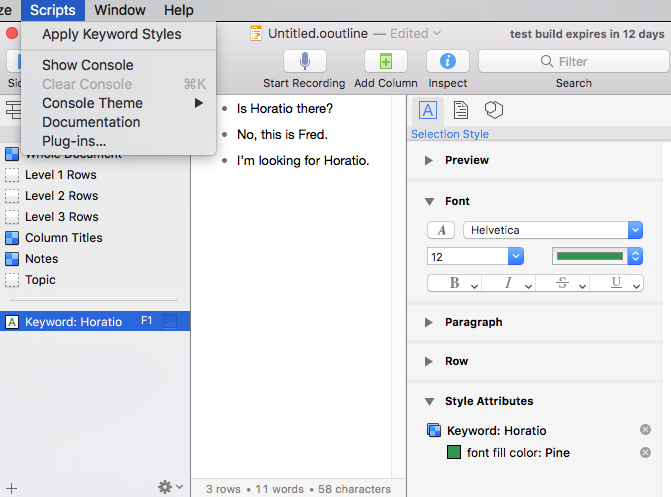With the upcoming built-in JavaScript automation (testable now as discussed in that thread, but lacking documentation) you’ll be able to create an automation handler which notices when a row changes and automatically updates its format based on that row’s content.
For example, to make rows red when they contain the word “red” you’d declare a handler along these lines:
var _ = function(){
var handler = new PlugIn.Handler(function(sender, item, column, state) {
console.log("invoke; sender: ", sender);
console.log("invoke; item: ", item);
console.log("invoke; column: ", column);
var outline = item.outline;
for (idx in outline.columns) {
var c = outline.columns[idx];
// console.log("looking at " + c);
// console.log("type is " + c.type);
// console.log("vs " + ColumnType.Text);
if (c.type == Column.Type.Text) {
var value = item.valueForColumn(c);
// console.log("value " + value);
if (!value) {
continue;
}
var string = value.string;
// console.log("checking string " + string);
if (string.indexOf("red") >= 0) {
item.style.set(Style.Attribute.BackgroundColor, Color.RGB(1.0, 0.5, 0.5, 1.0));
// console.log("found red");
return;
}
}
}
item.style.set(Style.Attribute.BackgroundColor, Color.RGB(1.0, 1.0, 1.0, 1.0));
// var styles = selection.styles;
// console.log("styles = " + styles);
});
return handler;
}();
_;
Sorry that we don’t have an actual working sample for you to try out and modify yet. The omni-automation.com website has mostly been focused on OmniGraffle automation (with a goal of having that ready to go when OmniGraffle 3 for iOS ships), but I’ll suggest to @Sal that we include an example along these lines when he shifts his attention to OmniOutliner and automation handlers.
For now, the script @SGIII posted above is a better answer since it’s an actual working solution (which is more useful than a not-yet-working proposal). Just wanted you all to know that you’ll be able to automate even more of this in the future! (As well as other handler-based logic like making a column be the sum of two other columns, etc.)


